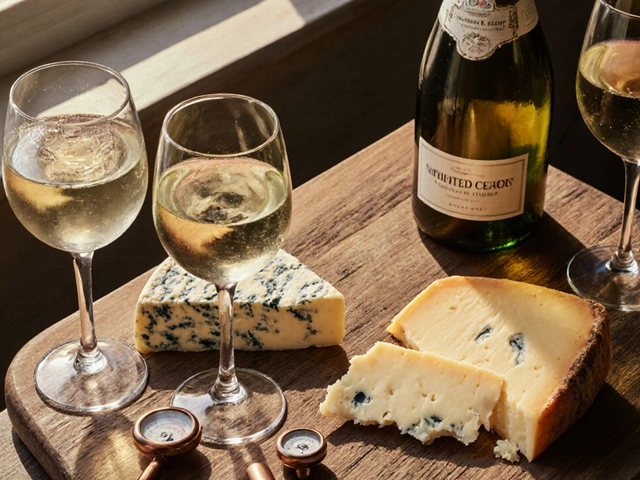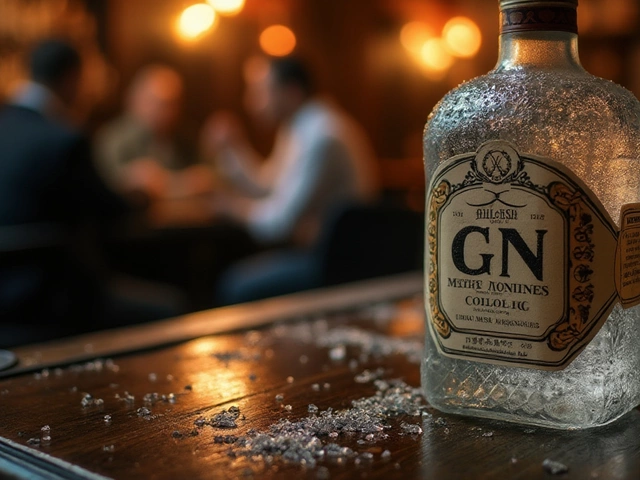Most people hear "wine and cheese," and their brain immediately jumps to red wines. But pour a chilled glass of white next to your cheese board, and you’ll realize everything you thought you knew might be upside down.
White wine actually pairs better with many cheeses than red does. The reason? It’s all about the acidity and freshness. Ever notice how a bite of brie with a crisp Sauvignon Blanc suddenly tastes brighter? That’s no accident. White wines typically have higher acidity, which cuts right through dense, buttery cheeses and cleans your palate for the next bite.
If you’re stuck picking, skip the urge to throw the fanciest Chardonnay in your cart. Think instead about how intense the cheese tastes—mild cheeses love light, zippy whites, while richer options need a wine with a little more body. Want to skip guessing? Grab a bottle of dry Riesling or Pinot Grigio; they’re the Swiss Army knives of wine and cheese pairings. Trust me, it’s hard to mess up with these.
- Classic White Wines and Cheese: A Quick Guide
- Why Acidity Matters More Than You Think
- Cheese Types and Their Perfect White Wine Matches
- Real-Life Pairings: What Works (And What Flops)
- Tips for Hosting a Foolproof Cheese & White Wine Night
Classic White Wines and Cheese: A Quick Guide
There’s a reason why people keep reaching for certain white wine and cheese combos—they just work, every single time. Let’s cut right to the chase and look at the bottles you’re most likely to see on shelves and what cheese they actually go with. Spoiler: you don’t need to break the bank here.
- Sauvignon Blanc: This is the go-to option if you’re dealing with goat cheese. It’s crisp, it’s zesty, and it makes those creamy, tangy goat cheeses pop. It also pairs well with feta, mozzarella, and even some milder cheddars.
- Chardonnay: If you like your cheese a little richer (think triple-cream brie or camembert), an unoaked Chardonnay gives you enough body to keep things interesting without overwhelming the cheese. Skip the big buttery Chardonnays for now unless you’re pairing with aged gouda or firm cheeses.
- Riesling: This wine is crazy versatile. Dry Rieslings are awesome with everything from gruyère and Swiss to blue cheeses if the wine leans a bit sweeter. The hint of sweetness helps balance out saltier, funkier cheeses.
- Pinot Grigio: Super light and bright, Pinot Grigio works well with less salty cheeses like havarti and mild goat cheese. It won’t stomp all over delicate flavors.
- Moscato: Sweet Moscato isn’t just for dessert. If you’ve got tangy blue cheese or even strong gorgonzola, the sweetness can cut right through the bold flavors and make things feel less heavy.
There’s some actual science behind this. Check out how acidity, residual sugar, and alcohol content stack up in popular white wines:
| Wine | Typical Acidity | Residual Sugar (g/L) | Common Cheese Matches |
|---|---|---|---|
| Sauvignon Blanc | High | 1-4 | Goat, Feta, Mozzarella |
| Chardonnay (Unoaked) | Medium | 1-3 | Brie, Camembert, Gruyère |
| Riesling (Dry) | High | 4-10 | Gruyère, Swiss, Blue Cheese |
| Pinot Grigio | High | 1-6 | Havarti, Goat, Chevre |
| Moscato | Medium | 35-120 | Blue, Gorgonzola, Strong Cheeses |
Basically, grab a white wine with good acidity if you want a no-brainer match. And don’t stress about exact brands—most bottles at your local shop will tick the right boxes if you use these basic rules.
Why Acidity Matters More Than You Think
This is where white wine really flexes its muscle. The acidity in white wine isn’t just for show—it’s what makes your wine and cheese combo actually taste better together. Acidity acts like a fresh squeeze of lemon over heavy food. It brightens, refreshes, and keeps everything from tasting too rich or one-note.
Here’s what’s happening: many cheeses—especially creamy ones like brie, camembert, or goat cheese—are loaded with fat. When you drink a high-acid white wine, the acid cuts through that fat like a knife, making every bite feel lighter. That’s also why biting into a chunk of cheddar and following it up with a sip of zesty white wine can feel almost palate-cleansing.
If you grab a white wine like Sauvignon Blanc, Riesling, or even a crisp Pinot Grigio, you’re getting a glass that’s higher in acid than most reds. These are some of the main champs when it comes to pairing. Take Sauvignon Blanc, for example: it usually sits around 7-8 grams of acid per liter—enough to stand up to strong flavors in cheese without getting lost. Now compare that to a buttery, oaky Chardonnay. The acid level is lower, so it sometimes falls flat with richer cheeses, especially if they’re extra creamy.
| White Wine | Acidity (g/L) | Cheese Pairing Strength |
|---|---|---|
| Sauvignon Blanc | 7-8 | Bright, tangy, perfect for goat cheese |
| Riesling (dry) | 6-9 | Keeps blue and funky cheeses in check |
| Chardonnay (oaked) | 5-7 | Best with harder cheeses like aged gouda |
| Pinot Grigio | 6-7 | All-rounder: mild to semi-hard cheeses |
Thinking about a cheese board for your next dinner? Go for at least one high-acid white wine. You’ll notice the food and wine just get along easier—and your guests might even think you know your stuff.

Cheese Types and Their Perfect White Wine Matches
Pairing the right white wine with the right cheese isn’t rocket science, but it does make a big difference. Not every bottle goes with every wedge, so knowing which combos click can take your cheese game up a notch.
Let’s break it down by cheese type, so you actually know what to grab for your next get-together (or just a night in):
- Fresh Cheeses (like mozzarella, goat cheese, feta): These are all about tang and creaminess. They do best with bright, high-acid wines. Pick Sauvignon Blanc or dry Riesling—both cut through the richness and won’t overpower the delicate flavor.
- Soft, Bloomy Cheeses (brie, Camembert): The creamy texture can be heavy, so you want a wine that cleans things up. Try Chenin Blanc or unoaked Chardonnay—these styles have enough punch without turning things into a flavor brawl.
- Washed Rind Cheeses (Epoisses, Taleggio): These stink a bit, but don’t let that scare you. Go for Gewürztraminer or Pinot Gris. Both handle bold flavors and weird smells like pros.
- Semi-Hard Cheeses (Comté, Gruyère, Emmental): These need something with backbone. A Pinot Grigio or a full-bodied Chardonnay works like a charm. You get a bit of richness, but not too much oak.
- Hard Cheeses (Parmigiano, aged Gouda): They’re big on flavor and a bit salty. Look for whites like aged Chenin Blanc or even a white Rioja. These can actually stand up to the cheese instead of fading away.
- Blue Cheeses (gorgonzola, Roquefort): Surprise—sweet whites are your friend here. Try Sauternes, Tokaji, or a late harvest Riesling. That sweet-and-salty clash is next-level.
And, here’s a handy cheat sheet if you want to keep it simple:
| Cheese Type | Best White Wine Pairing |
|---|---|
| Goat Cheese | Sauvignon Blanc |
| Brie | Unoaked Chardonnay |
| Gruyère | Pinot Grigio |
| Parmigiano-Reggiano | Aged Chenin Blanc |
| Blue Cheese | Sauternes |
Messing up a pairing isn’t the end of the world, but nailing it? That’ll have people asking for your secret. So next time, match your white wine with the cheese instead of just pouring whatever’s open—you’ll notice the difference immediately.
Real-Life Pairings: What Works (And What Flops)
Let’s cut to the chase—what actually delivers when it comes to pairing white wine with cheese? Not every combo is a home run. I’ve road-tested a bunch at dinner parties, and here’s what stands out (for better or worse).
Winners:
- Sauvignon Blanc with Goat Cheese: This is a classic for a reason. The zippy acidity in the wine makes creamy chèvre taste even richer and fresher. Friends who "don't like goat cheese" usually end up going for seconds.
- Riesling (dry) with Gruyère: Dry Riesling packs both fruitiness and acidity, taking Gruyère’s nutty flavor to a new level. If you've only had sweet Rieslings, try a dry one—big difference with cheese.
- Pinot Grigio with Mozzarella: Super easy-drinking and mild, Pinot Grigio won’t drown out young cheeses. Mozzarella balls and a glass of this? Snack heaven.
- Chardonnay (unoaked) with brie: Skip oaky Chardonnays unless you like fighting flavors. Unoaked versions give brie room to shine, making for a smooth and buttery combo.
Pairings That Flop:
- Sweet Moscato with Aged Cheddar: The sugar in Moscato battles with sharp, crumbly cheddar. It’s a mess—think drinking orange juice after brushing your teeth.
- Oaky Chardonnay with Blue Cheese: Both have huge personalities and together, it’s just chaos. The richness turns cloying and coats your mouth in a not-great way.
- Sauvignon Blanc with Washed Rind Cheeses: Stinky cheeses like Taleggio overpower light whites, leaving the wine tasting harsh or even sour.
If you want a clear snapshot of what to try and what to skip, check out this quick table:
| Cheese | Best White Wine | Pairing Rating |
|---|---|---|
| Goat Cheese | Sauvignon Blanc | Excellent |
| Gruyère | Dry Riesling | Great |
| Mozzarella | Pinot Grigio | Good |
| Brie | Unoaked Chardonnay | Great |
| Aged Cheddar | Moscato | Poor |
| Blue Cheese | Oaky Chardonnay | Disaster |
Trying it out for yourself is half the fun. Start with the solid pairings above and bring out the "fails" for a laugh—wine and cheese nights should never be too serious anyway.

Tips for Hosting a Foolproof Cheese & White Wine Night
Hosting a white wine and cheese night sounds fancy, but it’s not rocket science. The best part? No need for a huge budget or hours of prep. Here's how to keep things fun and stress-free while making your guests feel like VIPs.
- Mix up your cheese board: Offer a mix of soft, semi-soft, and hard cheeses. Think brie, goat cheese, Gruyère, and aged cheddar. This gives guests options and helps different white wine pairings shine.
- Pick a few reliable white wines: Don’t try to impress with rare bottles. Go for crowd-pleasers like Sauvignon Blanc, dry Riesling, Pinot Grigio, and unoaked Chardonnay. These wines match easily with most cheeses and won’t wreck your wallet.
- Serve wines and cheeses at the right temp: Chill your white wine to about 45°F (7°C). Take cheese out of the fridge about 30 minutes before guests arrive for the best flavor. Cold cheese tastes bland; you want it a bit soft.
- Offer simple pairings, then encourage mixing: Set up small cards with recommended matches (like brie + Sauvignon Blanc). But don’t fuss about rules—let people try their own combos. It’s more fun, and you’ll learn what really works.
- Add easy snacks on the side: Toss in a few bowls of nuts, some grapes, dried apricots, and baguette rounds. These extras help balance the flavors and give guests something to nibble between cheese and wine bites.
If you want to get a little geeky, here’s a quick data snapshot to help you plan quantities for your group of friends:
| Number of Guests | Cheese (oz per person) | Wine (bottles per 6 guests) |
|---|---|---|
| 6 | 5-7 oz | 2-3 |
| 12 | 5-7 oz | 4-6 |
| 18 | 5-7 oz | 6-9 |
One last tip: keep a pitcher of water nearby to clean palates (and, honestly, to slow things down). Don’t forget to grab a notepad—your friends might stumble onto a white wine and cheese matchup that’s way better than anything you’ve read online.


